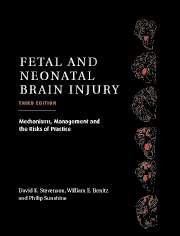Book contents
- Frontmatter
- Contents
- List of contributors
- Foreword
- Preface
- Part I Epidemiology, Pathophysiology, and Pathogenesis of Fetal and Neonatal Brain Injury
- Part II Pregnancy, Labor, and Delivery Complications Causing Brain Injury
- Part III Diagnosis of the Infant with Asphyxia
- Part IV Specific Conditions Associated with Fetal and Neonatal Brain Injury
- 26 Hypoglycemia in the neonate
- 27 Hyperbilirubinemia and kernicterus
- 28 Polycythemia
- 29 Hydrops fetalis
- 30 Acidosis/alkalosis
- 31 Meconium staining and the meconium aspiration syndrome
- 32 Persistent pulmonary hypertension of the newborn
- 33 Pediatric cardiac surgery: relevance to fetal and neonatal brain injury
- Part V Management of the Depressed or Neurologically Dysfunctional Neonate
- Part VI Assessing the Outcome of the Asphyxiated Infant
- Index
- Plate section
27 - Hyperbilirubinemia and kernicterus
from Part IV - Specific Conditions Associated with Fetal and Neonatal Brain Injury
Published online by Cambridge University Press: 10 November 2010
- Frontmatter
- Contents
- List of contributors
- Foreword
- Preface
- Part I Epidemiology, Pathophysiology, and Pathogenesis of Fetal and Neonatal Brain Injury
- Part II Pregnancy, Labor, and Delivery Complications Causing Brain Injury
- Part III Diagnosis of the Infant with Asphyxia
- Part IV Specific Conditions Associated with Fetal and Neonatal Brain Injury
- 26 Hypoglycemia in the neonate
- 27 Hyperbilirubinemia and kernicterus
- 28 Polycythemia
- 29 Hydrops fetalis
- 30 Acidosis/alkalosis
- 31 Meconium staining and the meconium aspiration syndrome
- 32 Persistent pulmonary hypertension of the newborn
- 33 Pediatric cardiac surgery: relevance to fetal and neonatal brain injury
- Part V Management of the Depressed or Neurologically Dysfunctional Neonate
- Part VI Assessing the Outcome of the Asphyxiated Infant
- Index
- Plate section
Summary
Introduction
The term “kernicterus” was originally used to describe the deposition of bilirubin in the basal ganglia. It was first described in 1903 by Schmorl. More recently, the term has also been used in reference to the neurological manifestations of hyperbilirubinemia. Another acronym, BIND, has been adopted to describe any bilirubin-induced neurologic dysfunction. Although technically the diagnosis of kernicterus can only be confirmed at autopsy, brain magnetic resonance imaging (MRI) studies may now aid in the confirmation of the diagnosis in a living child with severe jaundice. The MRI signature for kernicterus includes high signal intensity on T1-weighted (T1W) images in the globus pallidus (GP), internal capsule, thalamus, and hippocampi. The associated T2W images have abnormal increased signal in the GP and thalamus in the same regions as the high signal on the T1W images. Loss of demarcation between GP, internal capsule, and the anterior thalamus was the major finding (Figures 27.1 and 27.2). The source of these abnormal signals has not been definitively identified and therefore, the MRI findings should not be considered diagnostic in themselves, but only consistent with the diagnosis of kernicterus in the context of severe neonatal jaundice and the acute clinical features of kernicterus (Table 27.1).
Neonatal jaundice and neurotoxicity
Most often a benign condition, a majority of term neonates develop neonatal jaundice which is a consequence consequence of relatively increased bilirubin production (two- to threefold higher in a neonate compared to an adult) and limited ability to conjugate bilirubin in the transitional time after birth.
- Type
- Chapter
- Information
- Fetal and Neonatal Brain InjuryMechanisms, Management and the Risks of Practice, pp. 571 - 577Publisher: Cambridge University PressPrint publication year: 2003



